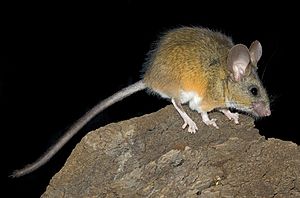California mouse facts for kids
Quick facts for kids California mouse |
|
|---|---|
 |
|
| Conservation status | |
| Scientific classification | |
| Genus: |
Peromyscus
|
| Species: |
californicus
|
The California mouse (Peromyscus californicus) is a type of rodent found in northwestern Mexico and central to southern California. It is the largest Peromyscus mouse species living in the United States.
What makes the California mouse special is its family life. Most rodents have many partners, but the California mouse is monogamous. This means a male and female mouse form a strong pair bond and stay together. They even work together to raise their babies! Because of this, scientists study them to learn more about how animals form partnerships and how fathers help care for their young.
Contents
Discover the California Mouse
The California mouse is easy to spot because of its unique features. It has very large ears. Its tail is also quite long, even longer than its head and body put together!
What Does a California Mouse Look Like?
These mice are usually between 220 to 285 mm long, including their tail. The tail itself can be 117 to 156 mm long. Their fur is a mix of brown and black hairs on their back. This color fades to a creamy-white on their belly. Their paws and feet are also white. Adult California mice are big enough that they might be mistaken for young woodrats.
Life in the Wild
California mice are mostly active at night. They spend their days resting and looking for food.
Where Do California Mice Live?
Even though they can climb trees a bit, California mice usually build their nests on the ground. They like to hide their homes under things like fallen logs. Sometimes, they even move into the old nests of woodrats for a season. They build cozy nests using dry grasses, weeds, and sticks for insulation. Inside, they use fine grass to make a soft bed.
How Do They Protect Their Home?
Both male and female California mice are very protective of their nest. They will defend their home from other mice. Males can be quite aggressive towards other males. They might jump, try to avoid attacks, and make a special squeaking sound. Sometimes, males that spend a lot of time fighting might spend less time helping to find food for their babies.
Family Life and Raising Pups
As mentioned, California mice form strong pair bonds. The male mouse plays a big role in raising the young. A mother mouse usually has only two babies at a time. However, a pair can have up to six litters in one year! It takes about 21 to 25 days for the babies to develop inside the mother. The young mice are ready to leave their parents when they are about five to six weeks old.
How Do California Mice Talk?
These mice communicate with each other using sounds that humans can't hear. These are called ultrasound sounds. When a male and female mouse are getting to know each other, their calls change. They go from sounding more aggressive to more friendly. Scientists can even guess how strong a pair's bond will be by listening to their calls!
What Do They Eat?
The California mouse enjoys a varied diet. They eat fruits, seeds, and flowers from shrubs. Some of their favorite plants include Rhus integrifolia, Lotus scoparius, and Salvia apiana. They also munch on grasses, wildflowers, mushrooms, and insects.
Who Are Their Predators?
Since they are small rodents, California mice have natural enemies. Their main predators are weasels and barn owls.


